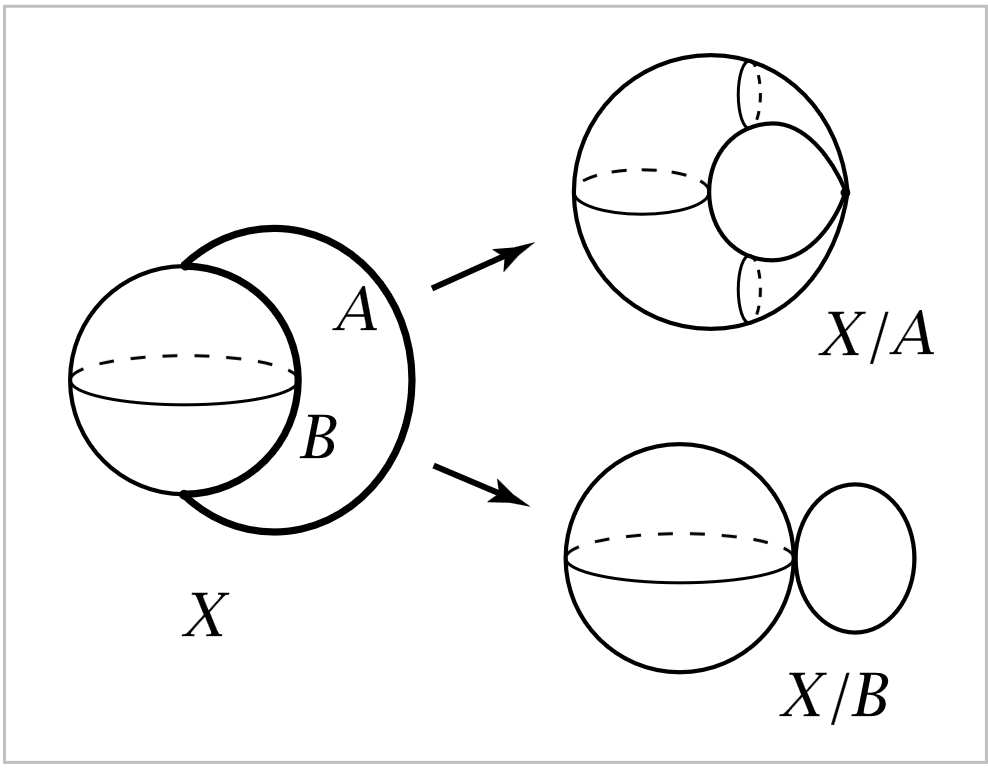nLab CW-pair
Context
Topology
topology (point-set topology, point-free topology)
see also differential topology, algebraic topology, functional analysis and topological homotopy theory
Basic concepts
-
fiber space, space attachment
Extra stuff, structure, properties
-
Kolmogorov space, Hausdorff space, regular space, normal space
-
sequentially compact, countably compact, locally compact, sigma-compact, paracompact, countably paracompact, strongly compact
Examples
Basic statements
-
closed subspaces of compact Hausdorff spaces are equivalently compact subspaces
-
open subspaces of compact Hausdorff spaces are locally compact
-
compact spaces equivalently have converging subnet of every net
-
continuous metric space valued function on compact metric space is uniformly continuous
-
paracompact Hausdorff spaces equivalently admit subordinate partitions of unity
-
injective proper maps to locally compact spaces are equivalently the closed embeddings
-
locally compact and second-countable spaces are sigma-compact
Theorems
Analysis Theorems
Contents
Idea
In algebraic topology, by a CW-pair is meant a CW-complex equipped with a sub-complex inclusion .
The concept appears prominently in the discussion of ordinary relative homology and generally in the Eilenberg-Steenrod axioms for generalized homology/generalized cohomology.
Properties
General
Proposition
For a CW complex, the inclusion of any subcomplex has an open neighbourhood in which is a deformation retract of . In particular such an inclusion is a good pair in the sense of relative homology.
For instance (Hatcher 2002, prop. A.5).
Proposition
For a CW-pair, then the -relative singular homology of coincides with the reduced singular homology of the quotient space :
For instance (Hatcher 2002, prop. 2.22).
Proof
By assumption we can find a neighbourhood such that has a deformation retract and hence in particular is a homotopy equivalence and so induces also isomorphisms on all singular homology groups.
It follows in particular that for all the canonical morphism is an isomorphism, by homotopy invariance of relative singular homology.
Given such we have an evident commuting diagram of pairs of topological spaces
Here the right vertical morphism is in fact a homeomorphism.
Applying relative singular homology to this diagram yields for each the commuting diagram of abelian groups
Here the left horizontal morphisms are the above isomorphims induced from the deformation retract. The right horizontal morphisms are isomorphisms by excision and the right vertical morphism is an isomorphism since it is induced by a homeomorphism. Hence the left vertical morphism is an isomorphism (2-out-of-3 for isomorphisms).
Collapsing contractible subcomplexes
Proposition
If the sub-complex is contractible, then the quotient coprojection is a homotopy equivalence.
Example
Let be the pushout (in Top) which attaches an arc — identified as — to the 2-sphere, connecting a pair of distinct points:

and let be any arc inside connecting these two distinct points. Then Prop. gives homotopy equivalences
In generalization of this example:
Example
For the result of subjecting a closed surface to punctures, the one-point compactification is homotopy equivalent to the wedge sum of the original surface with circles:
This follows from Prop. by generalizing Ex. as follows: Instead of a single arc, take and there to each be, in themselves, the linear graph consisting of arcs (edges) and observe that after identifying the vertices all with each other, this gives the wedge sum of circles.
Then take to be the result of attaching this graph to the closed surface by gluing the vertices to the marked points (the would-be punctures) and observe that . With similarly identified as the corresponding graph but now embedded inside , we have .
References
-
Allen Hatcher, Algebraic Topology, Cambridge University Press (2002) [ISBN:9780521795401, webpage]
-
Marcelo Aguilar, Samuel Gitler, Carlos Prieto, section 5.1 of Algebraic topology from a homotopical viewpoint, Springer (2002) (toc pdf)
Last revised on March 19, 2025 at 11:33:36. See the history of this page for a list of all contributions to it.